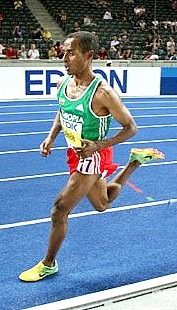Who doesn’t admire the forefoot running styles of Tirunesh Dibaba and Kenenisa Bekele? I for one do! But, the one thing that stands-out in their running form is how high their back kick is! Like Dibaba and Bekele, most East African runners have a very high back kick than most joggers, and here’s why that is:
Why Most Ethiopian Runners Have a High Back Kick
During the stance phase of running, the back kick represents a withdrawal mechanism, similar to a knee-jerk reaction. Withdrawal reactions are rapid and quick responses that are not consciously controlled. In walking, which involves heel striking and lesser impact, withdrawal of the swing leg is not immediately produced as it is when forefoot running, barefoot (Patla & Belanger. 1983).
Most Ethiopian runners ran barefoot and barefoot running is most implicated in this withdrawal reflex because the intensity of this reflex depends on the amount of tactile stimulation received by the foot from the ground –greater tactile stimulation produces a greater reflexive removal of the foot whereby running barefoot is the only way to guarantee high tactile stimulation.
Running Barefoot Means More Protective Landings

The purpose of quick, reflexive foot removal from the ground is to protect the foot from local damage and chronic overloading during barefoot running. Proprioception is at the root of high back kicking during barefoot running, which advances one’s ability to lower shock considerably. As a result, barefoot runners adopt a higher back kick to maintain sensations consistent with tolerable stable equilibrium (Robbins and Gouw, 1990).
In contrast, the culprit of a smaller, slower-responsive back kick is shoe cushioning because it allows the support surface to feel comfortable, therefore withdrawal response is slowed. To prevent this withdrawal reflex from deteriorating, barefoot running training would lead to a more effective, higher back kick, such as those influencing the performance of Ethiopian runners.
More From Run Forefoot:
- How to Prevent Runners Knee
- Amazing Barefoot Running Books
- How NOT to Swing Your Arms
- Best Shoes for Forefoot Running
PS. Don’t forget to check out the Run Forefoot Facebook Page, it’s a great place to ask questions about forefoot running, barefoot running, and footwear. I’ll be happy to answer them for ya!
References:
PatIa AE, Belanger M. Study of the response to nociceptive stimulus applied during walking in humans. In Winter DA et al. (Eds) Biomechanics IX-A, pp. 341-345, Human Kinetics Publishers, Champagin II, 1983
Robbins SE and Gouw GJ. Athletic footwear and chronic overloading – a brief review. Sports Med,1990; 9(2):76-85.
Bretta Riches
BSc Neurobiology; MSc Biomechanics candidate, ultra minimalist runner & founder of RunForefoot. I was a heel striker, always injured. I was inspired by the great Tirunesh Dibaba to try forefoot running. Now, I'm injury free. This is why I launched Run Forefoot, to advocate the health & performance benefits of forefoot running and to raise awareness on the dangers of heel striking, because the world needs to know.
Latest posts by Bretta Riches (see all)
- Heel Lifts Increase Injury in Runners - 16/04/2024
- Are Minimalist Shoes Good for Seniors? YES! - 14/04/2024
- BIG Deals On Running Gear And More! - 09/04/2024


Leave a Reply